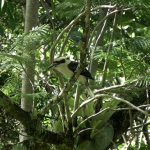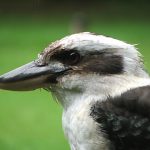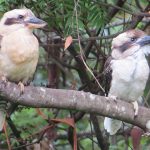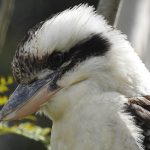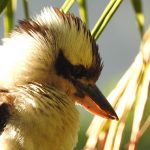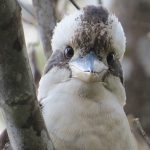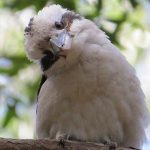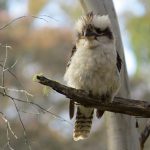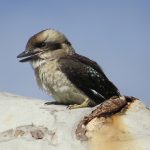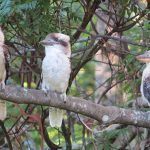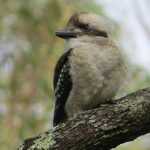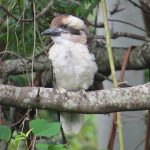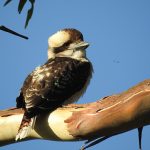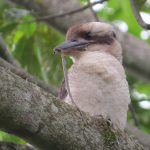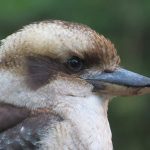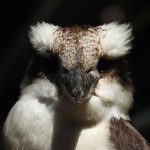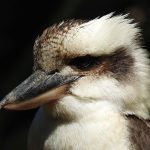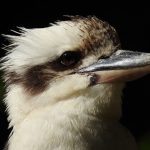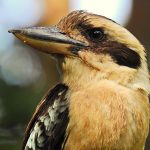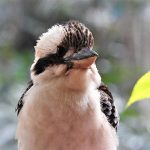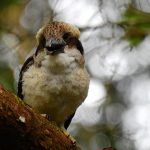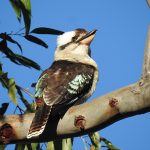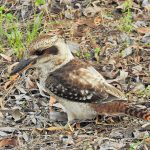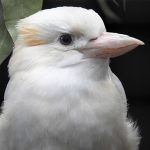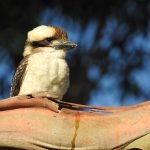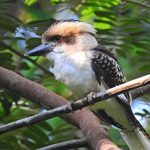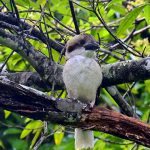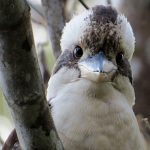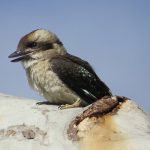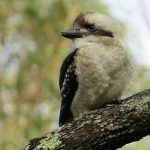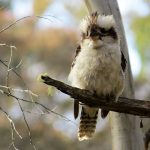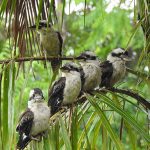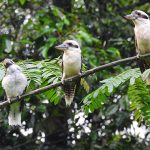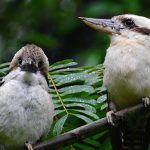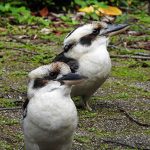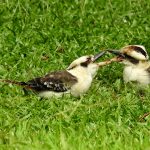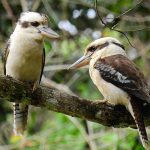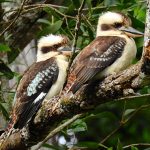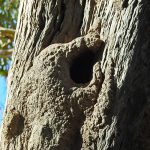LAUGHING KOOKABURRA
A Tale of Laughter in the Forest
Imagine the gentle hush of dawn in an Australian woodland. The world is still, wrapped in the pale light of early morning, when suddenly a chorus bursts forth—a vibrant, raucous laughter echoing through the eucalypts. This unmistakable call belongs to the Laughing Kookaburra, a beloved emblem of Australia’s natural heritage. Let’s journey into the daily life, habits, and fascinating adaptations of this extraordinary bird.
Story of the Kookaburra’s Dawn Chorus
Long before the first rays of sunlight reach the forest floor, a kookaburra lifts its head toward the sky. Its creamy chest feathers glow softly in the pre-dawn light, and as it begins its chorus—a cascade of booming, staccato notes—the sound rolls through treetops and across garden fences. For early European settlers, this sound was both eerie and enchanting, an unworldly laughter echoing in the dark expanse of the bush.
But for the kookaburra, this laughter signals territory and family bonds. Each morning and dusk, these calls affirm who belongs where, a ritual as old as the forest itself.
Diet: The Kingfisher That Rarely Fishes
Although dubbed a kingfisher, the kookaburra’s diet offers a surprise. Rather than diving for fish, kookaburras hunt on land. Perched with watchful eyes, they spot movement below—perhaps a skittering lizard, wriggling earthworm, or an unsuspecting mouse. In an instant, they swoop down, capturing their prey in a strong beak. Gripping it firmly, they return to their perch and dispatch the prey by beating it against a branch, a swift, purposeful act.
Their menu is broad and hearty:
- Small snakes and lizards
- Mice, rats, and the occasional small bird
- Insects such as grasshoppers, beetles, cicadas, and caterpillars
- Spiders, snails, worms, frogs, and even yabbies or crayfish from shallow water
Like raptors, much of their moisture comes from their prey, so they rarely drink water.
Kookaburra’s Physical Features and Identification
Kookaburras possess a striking appearance:
- Head: Off-white, marked with a dark stripe across each eye and through the crown
- Mantle and Wings: Dark brown, flecked with light blue on the shoulders
- Back and Tail: Russet brown with black bands
- Underparts: Entirely off-white, with a faint hint of grey along the sides
- Eyes: Deep, dark brown, bright and intelligent
Males have extra blue flecks along the lower back and tail. Their feet are notable too:
- Three toes face forward, with the second and third ones joined for most of their length
- One toe faces backwards
- This formation aids in nest excavation but makes walking tricky, so they hop along the ground
Social Life of the Kookaburra: Close-Knit Families
Kookaburras live in permanent family groups, bound by loyalty and a clearly defined hierarchy. At the heart is a dominant breeding pair, surrounded by their offspring—both mature and juvenile—as well as other adult helpers.
- Breeding Season: September to January
- Nesting: Preference for tree hollows, old limbs, or sometimes termite mounds
- Eggs: 1-4 round, white eggs per clutch
- Incubation: About 24 days; all group members share in keeping eggs warm and guarding the nest
After about five weeks, fledglings begin to fly but continue receiving food and guidance for another three months. Many young kookaburras remain with their family for several seasons, acting as helpers and defenders.
Kookaburras distribution and Habitat
| Region | Habitat Types |
|---|---|
| East Coast of Australia | Open forests, woodlands, suburban gardens |
| South-East South Australia | Eucalypt woodlands, suburban areas |
| Introduced regions | Southern Western Australia, Tasmania |
Kookaburras thrive in diverse environments—from serene bushland to bustling city parks. Their presence in picnic grounds and schoolyards highlights both their adaptability and the gentle encroachment of human habitats into the natural world.
Sounds, Senses, and Conservation
What does the Kookaburra sound like: The kookaburra’s call is unforgettable—rolling, infectious laughter that builds and echoes, creating a vivid sense of space and life.
Tactile & Visual: The heavy form of a kookaburra on a branch, feathers ruffled in the breeze, blends beautifully with the dappled light of gum trees.
Scent: The earthy aroma of eucalyptus mingles with the fresh, humid air after rain, as kookaburras perch alert on sun-warmed branches.
While it may be tempting to offer food to these birds, human-provided diets can lead to nutritional deficiencies, malformed young, and unbalanced populations. Rat poisons also pose a threat, as kookaburras eating poisoned rodents may fall ill themselves. Simple acts, like trapping introduced pests instead of using poisons and preserving old trees with hollows, give kookaburras hope for a healthy future.
Guardians of the Field and Forest
The Kookaburra is more than just the laughter in the treetops; it’s a tireless guardian of our gardens and bushlands, a vital part of Australia’s living tapestry. Their stories remind us of the delicate threads connecting all life and the importance of safeguarding the wild places we share.
By observing the Kookaburra—its voice, its flight, its family—we step into a richer world, full of wonder and responsibility. Let the laughter of the Kookaburra inspire care for the living world, so these ancient melodies echo across Australia for generations to come.
For further reading and resources on Australian native birds and their conservation, visit:
Every morning, as the forest awakens in a chorus of sound, the Kookaburra calls us to listen—to the land, its stories, and the enduring need to protect the wild.

